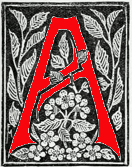


Left to right: (a) A simple wooden hornbook of 1785-1815, © Victoria and Albert Museum of Childhood (British Library public domain image, MISC.239-1978). (b) A rare example, showing front and back, from just after King Charles I's execution in 1649. Source: Tuer 34. (c) Georgie Gaskin's Spring shows a young girl with her hornbook. Source: Tuer, facing p.46. [Click on the images to enlarge them.]
 hornbook usually consists of a piece of parchment or paper lesson pasted onto a paddle-shaped piece of wood, as in the middle example above. The name derives from the leaf of horn, made from sheep and goat horn that was softened and then boiled in water to produce true horn that could be pressed and cut into sheets, that was attached to the board by a brass or latten border by minute tacks. Hornbooks generally presented the alphabet above arabic numerals and the Lord's Prayer. This evidence of rudimentary letter-learning and the hardiness of the hornbook itself speaks to the very young audience the hornbook aimed to please, and more importantly indicates a tradition of reading material for the very young that dates back to the Middle Ages. St. Cecilia is depicted holding a hornbook in the Nuremberg Chronicle, published in 1493. By the nineteenth century, the prevalence of printed and bound alphabet and rhyme books made hornbooks less popular, however, they remained a staple in Victorian children's nurseries well into the century.
hornbook usually consists of a piece of parchment or paper lesson pasted onto a paddle-shaped piece of wood, as in the middle example above. The name derives from the leaf of horn, made from sheep and goat horn that was softened and then boiled in water to produce true horn that could be pressed and cut into sheets, that was attached to the board by a brass or latten border by minute tacks. Hornbooks generally presented the alphabet above arabic numerals and the Lord's Prayer. This evidence of rudimentary letter-learning and the hardiness of the hornbook itself speaks to the very young audience the hornbook aimed to please, and more importantly indicates a tradition of reading material for the very young that dates back to the Middle Ages. St. Cecilia is depicted holding a hornbook in the Nuremberg Chronicle, published in 1493. By the nineteenth century, the prevalence of printed and bound alphabet and rhyme books made hornbooks less popular, however, they remained a staple in Victorian children's nurseries well into the century.

Phil May's comic sketch suggests that the hornbook could be used for punishment, too. Source: Tuer, facing p. 20.
Bibliography
Children's Literature, Chiefly from the Nineteenth Century. Patrick Scott, text and Jason A. Pierce, hyper-text. 1999. Thomas Cooper Library, University of South Carolina. 8 July 2007.
Demers, Patricia, ed. From Instruction to Delight: An Anthology of Children's Literature to 1850. 2nd ed. Canada: Oxford University Press, 2004.
Tuer, Andrew White. History of the Horn-Book. London: The Leadenhall Press, 1897. Internet Archive. Contributed by the Wellcome Library. Web. 1 February 2921.
Last modified 1 February 2021; images and captions added by JB